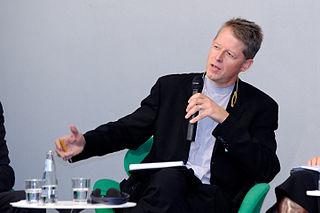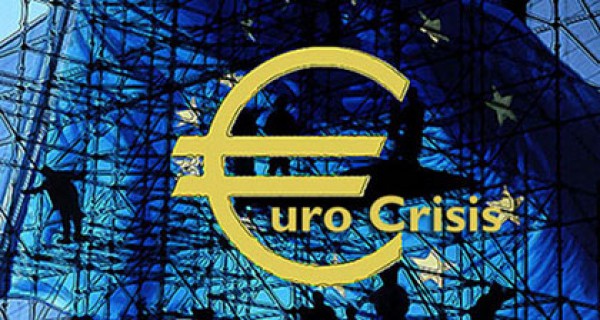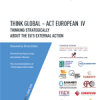The debate on Europe is largely dominated by doomsayers. The dominant discourse is that the European Union is in disarray. European policymakers are unable to get their act together. There is an increased rift between the creditor North and the indebted South. Economically speaking, Europe will be stuck in a recessionary environment for the next ten years, or more. Demographically, Europe is getting older by the day. And what is worse, the energy necessary to keep all these old people warm needs to be imported. Socially, there will be increased tensions between the ‘haves’ and the ‘have-nots’ and between nationals and foreigners, who are absolutely necessary to fund the pensions of the elder, but who are unwelcomed by an Old Continent full of bigotry. For all these reasons, Europe is bound to be less influential in foreign affairs. Its overall structural decline is unstoppable. The best scenario the Europeans can hope for is for the EU to become a huge museum.

Fortunately, the always controversial Andrew Moravcsik disagrees with this fatalistic assessment on the future of Europe. In a recent lecture given at Johns Hopkins University, he makes the bold claim that Europe not China will be the next superpower alongside the US. This might sound Eurocentric, but Moravcsik has a point. The EU as a bloc remains the second biggest military power in the world, with two countries, the UK and France, permanent members of the UN Security Council. The EU has also the largest GDP and it is by far the biggest exporter of goods and services and the largest receiver and sender of foreign direct investment in the world. Per capita income in the EU is $32.000. In China it is $6.000. This is on the hard power side. On soft power, the EU excels even more. It is by a big margin, the biggest aid donor and the largest contributor to international organisations, and it has more foreign students in its universities than the US. When pollsters ask people around the world what kind of political system do they like the most, 50 percent prefer the European model while only 25 percent choose the US. Taking into account the life expectancy, the welfare systems, the amount of vacations, and the social rights in the Old Continent, is there any surprise that most people in the world would like to be born in Europe?
Moravcsik is right when he says that the problem of Europe is that it is engulfed in pessimism. The US by contrast is in a permanent self-promotion campaign. Europe should be much prouder of what it has. Right now official unemployment figures are twelve percent in the EU and seven percent in the US. At first glance these numbers indicate the US is coming out of the crisis faster. But appearances are deceptive. If we count US workers that have given up looking for work, the US unemployment figure is around ten percent. Furthermore, it needs to be remembered that before the crisis the unemployment rate in the EU was already at eight percent, while in the US it was at five percent. Although there are 27 million unemployed in the EU, certainly a dramatic figure, there are 42 million Americans living on food stamps, almost the equivalent of the entire population of Spain. More importantly, inequality is lower in Europe than in the US. Even relatively unequal countries such as Greece, Italy, Portugal and Spain have Gini coefficients lower than the US.
Where I disagree with Moravcsik is when he says that the Euro was a mistake. This is also becoming a dominant discourse. Martin Feldstein embodies this line of thinking by claiming that “the euro should now be recognized as an experiment that failed”. My colleague in the International Political Economy (IPE) field, Mark Blyth, calls the Euro a “monetary doomsday device”. I would like to counter-argue these claims. The situation is by all means not rosy in the Eurozone. A lot needs to be done to fix the problem. Essentially for the Euro to survive it needs a European sovereign. A tall order which will not be achieved in a few late night Eurosummits. But a bit of perspective is warranted in order to recognise what has been constructed in the past decades, and especially, in the past three years.
First of all we need to remember why the euro was created in the first place. Sometimes people think that its principal aim was to consolidate the single market, to reduce transaction costs and to avoid destabilising exchange rate volatility and beggar-thy-neighbour devaluations. While this is true, as Nicola Jabko has demonstrated, there was also a hidden agenda in the creation of the Euro, which was to regain monetary sovereignty in an increasingly globalised world. If we analyse the single currency from an international monetary power perspective, the euro was created to enhance the Eurozone’s monetary autonomy. To function as a shield against the inherent instabilities in the dollar centred international monetary system of free capital flows. Seen from this point of view, the euro has been the victim of its own success. It has protected so effectively the weakest and less competitive countries of the Eurozone from the pressures of globalization (the inclusion of hundreds of millions of workers from emerging markets in the global economy) that they were able to delay their macroeconomic adjustment and structural reforms for ten years.
Now, as we all know, there is no free lunch in Economics. You can delay adjustment, but one day adjustment will come. By attracting huge external demand for euro-denominated debt, the euro offered a cosy shelter to Eurozone member states. But suddenly, when the continuous storm of globalisation was transformed in a hurricane – the external shock of the global financial crisis – the Europeans realised that their house was built on shaky pillars. Even so, they were able to build a more robust edifice almost from scratch. Not an easy task. Remember that in 2010, when the Greek crisis blew up, the little European expertise and know-how there was on how to deal with sovereign defaults was sitting in Washington DC at the IMF. Europe was totally unprepared for such a situation. Yes, this is how sad the situation was. Hence, considering the lack of resources and human capital at hand, what the Europeans have achieved is almost miraculous. If someone would have told me five years ago that in 2013 there would be a de facto European monetary fund, called the European Stability Mechanism, able to transfer up to €500bn from creditor to debtor countries, I would tell her or him you are mad. I would respond: “the Germans will never agree”. The fact is that it is here, and so is the fiscal compact, the six pack, the two pack and the euro plus pact. The Eurozone periphery has started to undertake painful structural reforms. And what is even more surprising, the centre left and right managed to form coalitions in Greece and Italy. Who would have thought that? As Fred Bergsten has pointed out, when analysing the Eurozone crisis look at what the Europeans do rather than what the say.
However, someone like Paul De Grauwe might say: yes, this is all fine and good, but there is still too much focus on penalising fiscal deficits and no strategy to generate growth. The doom loop between national banks and sovereigns has not been solved and the ECB is still too hawkish resisting embarking into a quantitative easing programme which could provide credit to European SMEs and lower the exchange rate of the Euro. I agree with De Grauwe and Mark Blyth. I think Brussels and Berlin have put too much emphasis on austerity and very little on growth. However, we should not underestimate what has been achieved so far. European policymakers are currently negotiating the construction of a European banking union. These are big words. Furthermore, we should also recognise how we got here. I would argue, and this is in line with Jakob Kirkegaard, that the aforementioned steps towards a fiscal and banking union would not have happened without the ECB playing continuous ‘games of chicken’ with Eurozone political leaders. The ECB, as the only truly federal European institution around, has cleverly used its power to push for further integration. I doubt whether European leaders would have gotten here without the ECB.
Let me just give a few concrete examples to illustrate this point. In 2010, the ECB decided to start the Securities Market Programme (SMP) and buy bonds from crisis hit Eurozone peripheral states only when European leaders, including Angela Merkel, agreed to create the European Financial Stability Facility on that historic Sunday night of the 9 May. In 2011, the same sequencing happened. The ECB started its Long Term Refinancing Operations (LTROs) once European leaders signed the Fiscal Compact. In 2012 events were not different. Mario Draghi only delivered his game-changing “whatever it takes” speech in July and proposed its OMT programme in September after European leaders had agreed in June the establishment of a banking union. Ironically, yet again, the ECB has been the victim of its own success. Draghi’s OMT has calmed the markets and taken off the pressure for further integration. Since the OMT was announced Germany has rowed back on its commitment. It is to be seen how the negotiations evolve. I am cautiously optimistic because even if we fall back into a new crisis, this will be again the moment when further integration is more likely. This is sad. But that’s how Europe works. As Jean Monnet declared, “Europe will be forged in crises, and will be the sum of the solutions adopted for those crises”.
Now, the euro-sceptics might say, this is playing with fire. The real solutions might come too late. Europe is playing Russian roulette. The situation is so dramatic in the Eurozone periphery that it can all backfire. There is the risk that populist parties might get into power and call for a withdrawal from the Euro. While this possibility cannot be discarded, it is still unlikely. First of all, parties such as the Greek Syriza or the Italian Five Star Movement, which are widely labelled as anti-euro, are not such. Quite the opposite, they want to have more democracy at the European level. They are euro-critics because they want a different EU, but they are not anti-European. Second, the xenophobic parties, such as Le Pen’s Front National in France and Wilders’ Freedom Party in Holland, were around before the crisis and they still need to show that they have attracted massive new support. So far they have not. Finally, in the Southern countries there is a lot of anger with the EU, but until now support for the single currency is strong. The latest poll by the PEW Research Center conducted in 2013 shows that 69 percent of Greeks, 67 percent of Spaniards and 64 percent of Italians want to stay in the Euro. As Lionel Barber, editor of the FT, has pointed out, before you decide you want to leave the Eurozone, you need to think where you want to go.
Let’s take a country like Spain. One could say, well Spain is not the UK (it does not have the same institutional credibility), but it can certainly do as well as Poland, a country that has performed strongly outside the Eurozone with robust growth throughout the crisis thanks among other things to its capacity to devalue. However, as a matter of fact, and despite the deep crisis, Spain’s per capita income is $30.000 in purchasing power parity (PPP) terms and 27.000 in nominal terms, while that of Poland is $20.000 in PPP terms and $12.000 in nominal value. Again, the Euro functions as an effective shelter that no-one in the Southern periphery is ready to abandon easily, and they have good reasons to think this way. Life outside of the Eurozone can be bitterly cold.



